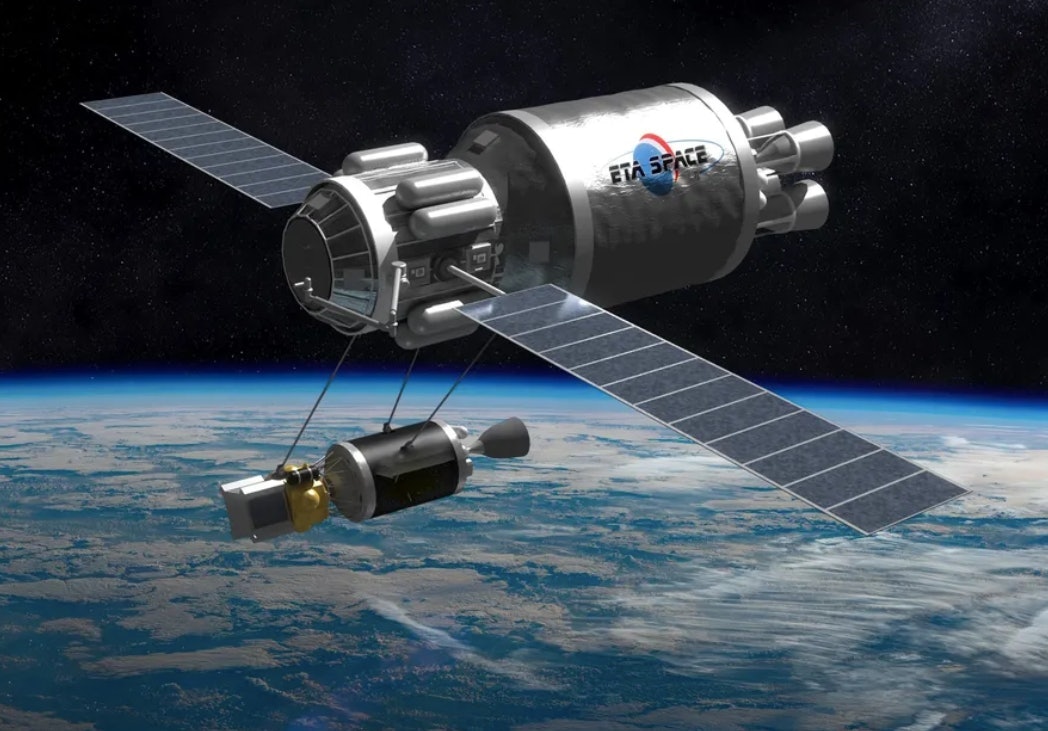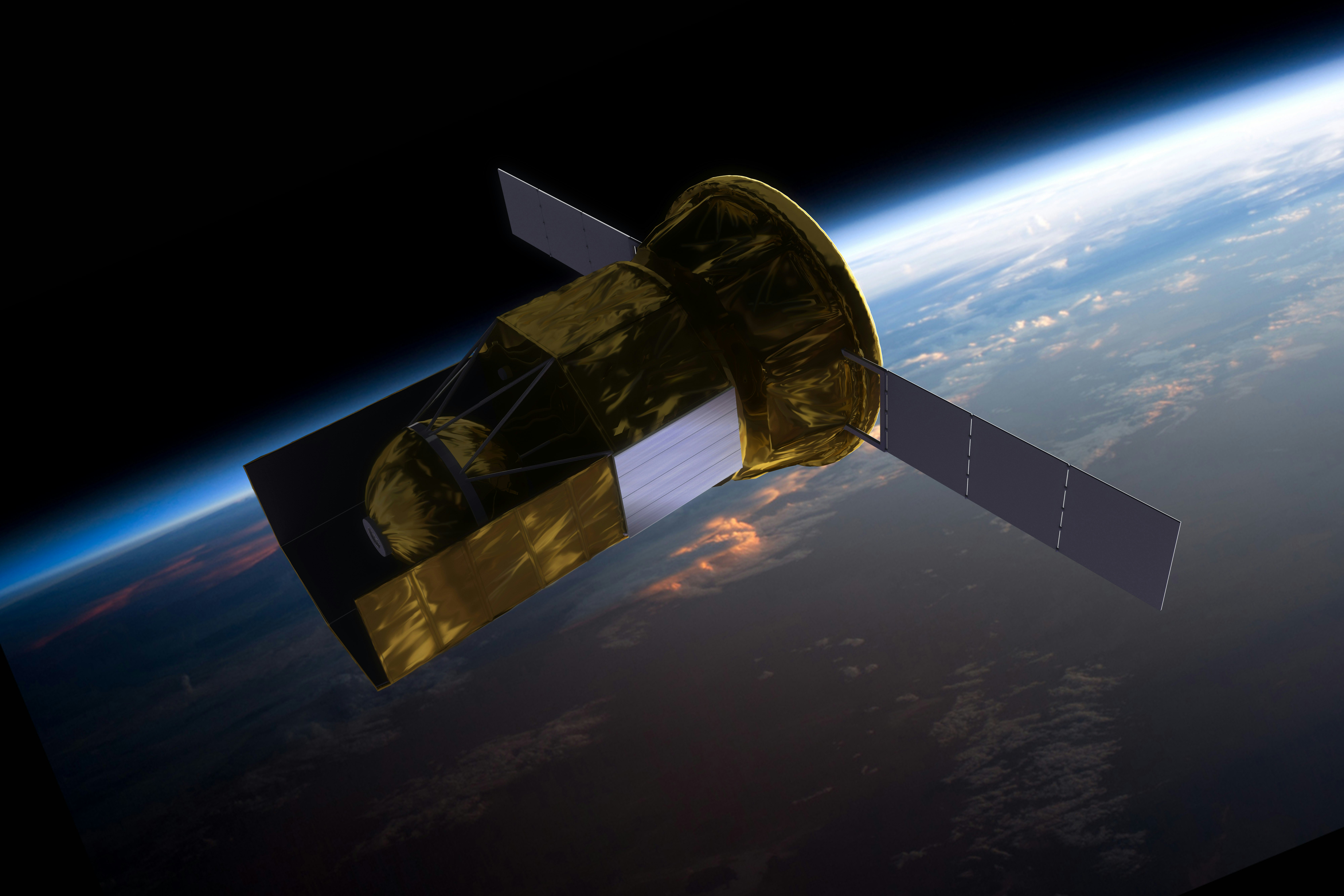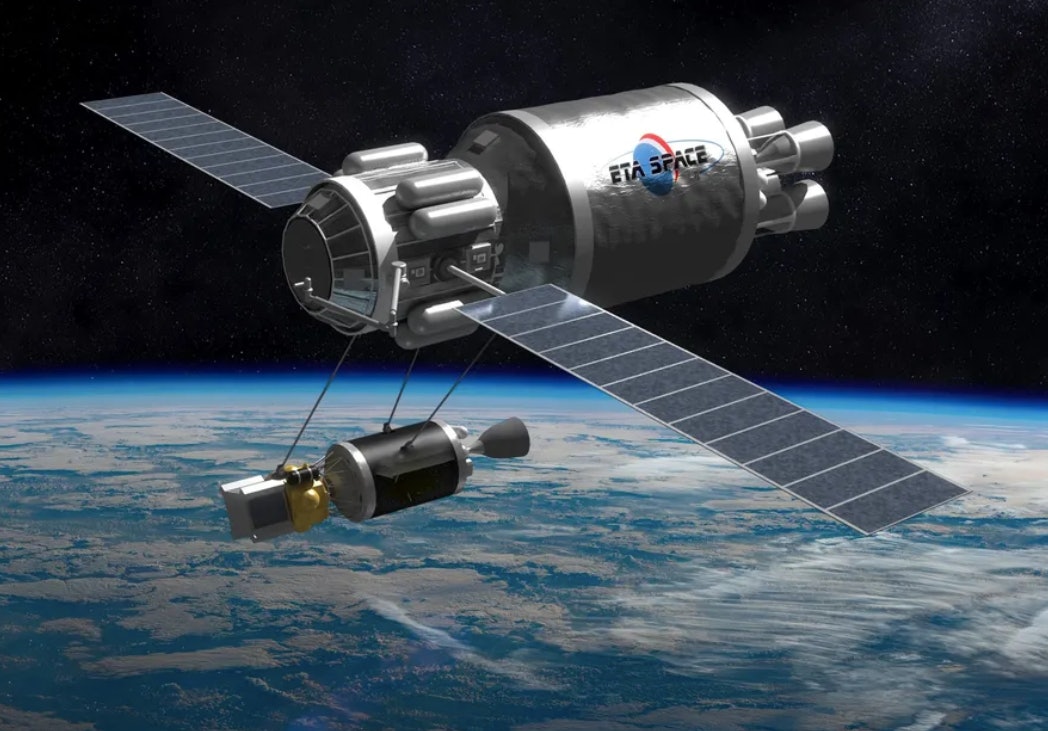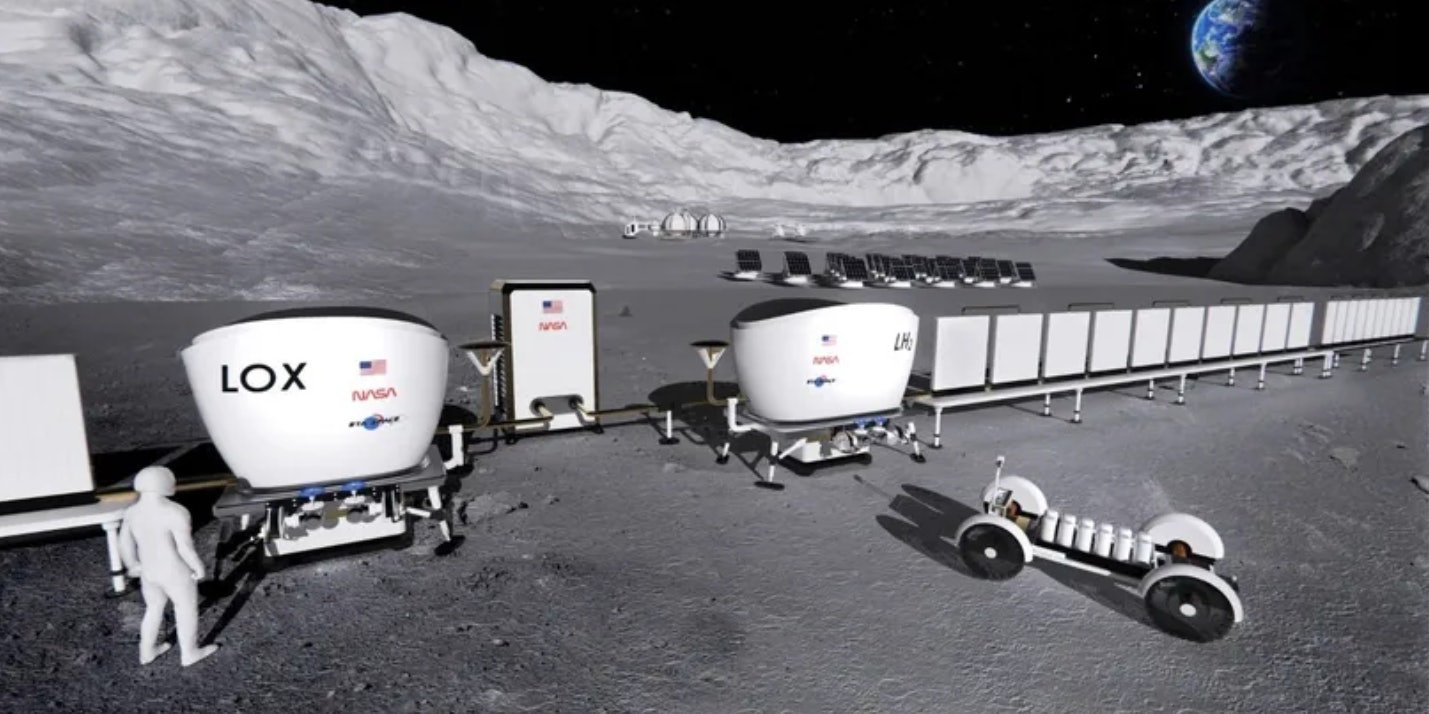
Perhaps the hardest part of sending people into space is actually getting to space in the first place.
Any rocket capable of escaping Earth’s atmosphere needs to burn most of its fuel within the first few minutes of launch, severely limiting what it can do or where it can go once in space.
“The goal is to provide propellants from the surface of the Moon.”
One company aiming to get around this limitation is ETA Space. It is building what is effectively a gas station in Low Earth Orbit, so that instead of falling back to Earth or just taking up space as the tank runs empty, rockets and satellites may be able to live longer and travel farther.
“It allows the payload customer to buy a smaller rocket to send it up and then refuel. So instead of spending $150 million on a rocket, you might spend $20 million on a smaller one,” Bill Notardonato, the CEO and founder of ETA Space, tells Inverse.
He believes ETA’s gas station concept, which it calls “CryoDock,” could enable more players to send missions to places humans are yet to reach — including Mars — by making the entire endeavor easier and cheaper. Eventually, ETA wants to set up a station at strategic junctures in space, like the Moon.
“Eventually the goal is to provide propellants from the surface of the Moon, you’ll get hydrogen and oxygen from the water there. But before that, we would refuel in Low Earth Orbit,” Notardonato explains.
ETA Space’s gas stations will likely serve organizations with large, expensive satellites and spacecraft that are geared to travel long distances in space, he adds.
“Say they're launching a mission to Jupiter. You could launch and get into orbital insertion, and then [the fuel tank will] be mostly empty.” This is where ETA Space’s LOXSAT, or cryogenic fuel station, would theoretically come in to replenish the fuel and send the spacecraft on its way.
“You’ll get hydrogen and oxygen from the water there.”
Sending a rocket up with less fuel means there can be less rocket, too — lower volumes of fuel require less thrust and, in turn, smaller launch vehicles to make it to space.
“You could top [the tank up] and refuel to get the energy to do the Earth departure burn. So all of a sudden now, science missions can launch on smaller launch vehicles and send larger masses, both to the inner and outer Solar System.”
To get the fuel to space in the first place will require a very large launch — until ETA can set up on the Moon of course. Notardonato says that the scale may work to the company’s advantage, however — ultimately, other partners will save on their launch costs.
“Let's say we launch 15 metric tonnes of propellant, but each customer only needs 500 kg. We can do 30 different servicings and so we get the economies of scale that way.”
Enter, LOXSAT 1

The first step to building its in-orbit refueling business will come in the form of LOXSAT 1, a small demonstration satellite that will test two of ETA Space’s core technologies. The test has already been paid for by NASA. Costing $27 million, ETA Space and the agency plan to start building LOXSAT 1 in January 2023. A launch window may come as soon as March 2024.
LOXSAT 1 is designed to prove that cryogens like liquid oxygen (“LOX”) can be stored for long periods in space. Though the fuel has been used for a number of rockets, including in the first stage of SpaceX’s Falcon 9, it hasn’t been considered “storable” before now. In turn, deeper space missions have tended to use “hypergolic” fuels that combust on contact, like monomethylhydrazine and nitrogen tetroxide. So if humans are to go deeper into space, we’ll need to find an alternative to these dangerous fuels.
“They're very toxic, very hazardous, and difficult to handle on the ground. Not environmentally friendly at all, and they're not easy to make. If you go to the Moon or Mars, you're not going to be making your own nitrogen tetroxide for a while,” says Notardonato. LOX could provide an alternative — if it can be stored.
“We don't have a history of storing large quantities of cryogens in space for long periods of time, because they boil off,” explains Notardonato.
“Hydrogen in particular boils at 20 degrees above absolute zero. So in space, any solar radiation that hits it and any radiation from the Earth that hits it goes directly into heating the liquid which boils, and so you tend to lose your propellant.”
“Long term zero boil-off storage is one of the key technologies that we're going to prove. We've done it on the ground numerous times. Now, we just need to prove it in microgravity.” he adds.
“SpaceX will be the Mac and we'll be the PC.”
The LOXSAT mission will also help to prove another critical aspect of CryoDock: Whether fuel can be pumped from one spacecraft to another while in space.
“The first tank is cold, but the second tank is warm, and the transfer line is typically warm,” explains Notardonato. “As [the fuel] chills down to the other system, it boils off and creates more vapor. So you have to vent that vapor.”
So far, no one has managed to demonstrate fuel transfer in space.
“It takes so much energy and so much cost to lift a kilogram of mass up to orbit. If you're losing, [say], 20 percent of that during transfer because of chill down, it's just very uneconomical. [But] we have methods that we've developed that can do no-loss chill downs, and no loss transfers from tank to tank,” Notardonato says.
There are some big “what ifs” that need to be answered, however — something Notardonato acknowledges.
“What we're not as confident in is the fluid behavior in microgravity,” says Notardonato, who explains that there are “liquid acquisition” devices inside fuel tanks that, under Earth’s gravity, use surface tension to direct the fuel out of the tank. But it isn’t clear if they will behave the same way in space.
The company is putting a camera inside the liquid oxygen tank to see for themselves.
“A few people have flown cameras in space to observe cryogenic liquids but they've typically been on either the first stage and the second stage [of a launch rocket]. So you get 10 to 15 minutes, maybe half an hour of microgravity data,” he says.
“We're going to have nine months' worth of microgravity data and we're going to be able to vary thrust levels, rotation rates, things like that. So that we'll accurately be able to anchor all these zero-G models that NASA and other researchers have been working on for years.”
The long road to a cosmic gas pump

ETA Space is not the only company working on the problem of storing propellant in space. In fact, if humans are to establish a permanent presence on the Moon, SpaceX will need to figure out how to refuel its Starship-based human landing system. But fundamentally, Notardonato believes ETA is doing something different.
“We're cramming as many technology demonstrations into a small mission over a long period of time as we can and we're trying to make it more of an agnostic type of approach,” explains Notardonato.
“With SpaceX, their development money is going towards their mission architecture only. And United Launch Alliance is gearing theirs towards the upper stage of their architecture only. We want to create a propellant depot called Cryodock that is commercially available to anybody that uses our standardized umbilical disconnects.”
“SpaceX will be the Mac and we'll be the PC,” he says.
ETA Space: The timeline

So when will LOXSAT 1 blast off? There’s a long road ahead, Notardonato says.
“June 15 we're scheduled to have our critical design review with NASA. At that point, our design is about 95 percent complete,” says Notardonato.
“We've issued most of the major procurements for the electronics, the radiators, the structures, the tanks, and the valves.”
“It’ll take about three months to fabricate in the shop.”
Then it will be six months of waiting for the parts, and sub-system testing as they arrive.
“We're going to start putting the entire thing together in January of next year,” he says.
“It’ll take about three months to fabricate in the shop. And then we're going to have about four months to test our payload here before we ship it to Rocket Lab. Rocket Lab will take it and mate it up with their vehicle, and then we do six months' worth of integrated tests on that.”
Key dates:
- June 15, 2022: NASA reviews ETA Space’s design for LOXSAT 1.
- December 2022 - January 2023: ETA Space gets the parts it needs and starts initial testing.
- January 2023: Construction on LOXSAT 1 begins.
- March 2023: Earliest possible window for LOXSAT 1 to be completed.
- July 2023: Potential window to ship LOXSAT 1 to Rocket Lab — the company launching the satellite.
- Winter-Spring 2024: Rocket Lab completes attaching LOXSAT 1 to the launch vehicle and testing.
- March 2024: Earliest possible launch window for LOXSAT 1.
On the horizon…
The hope is that LOXSAT 1 will launch aboard a Rocket Lab Electron rocket in March 2024 from a launch site in New Zealand. If successful, it will then be up to LOXSAT 2 to turn what its predecessor proves into a viable commercial business.
That will (literally) be a much bigger deal, Notardonato says.
“We have a lot of things going on with LOXSAT 2 that I can’t talk about,” he says, but he hints it will be a larger payload than LOXSAT 1.
“But if we launch off a Rocket Lab vehicle, it will have to be something bigger than the Electron.”
HORIZONS is a newsletter on the innovations of today that will shape the world of tomorrow. This is an adapted version of the May 26 edition. Forecast the future by signing up for free.







